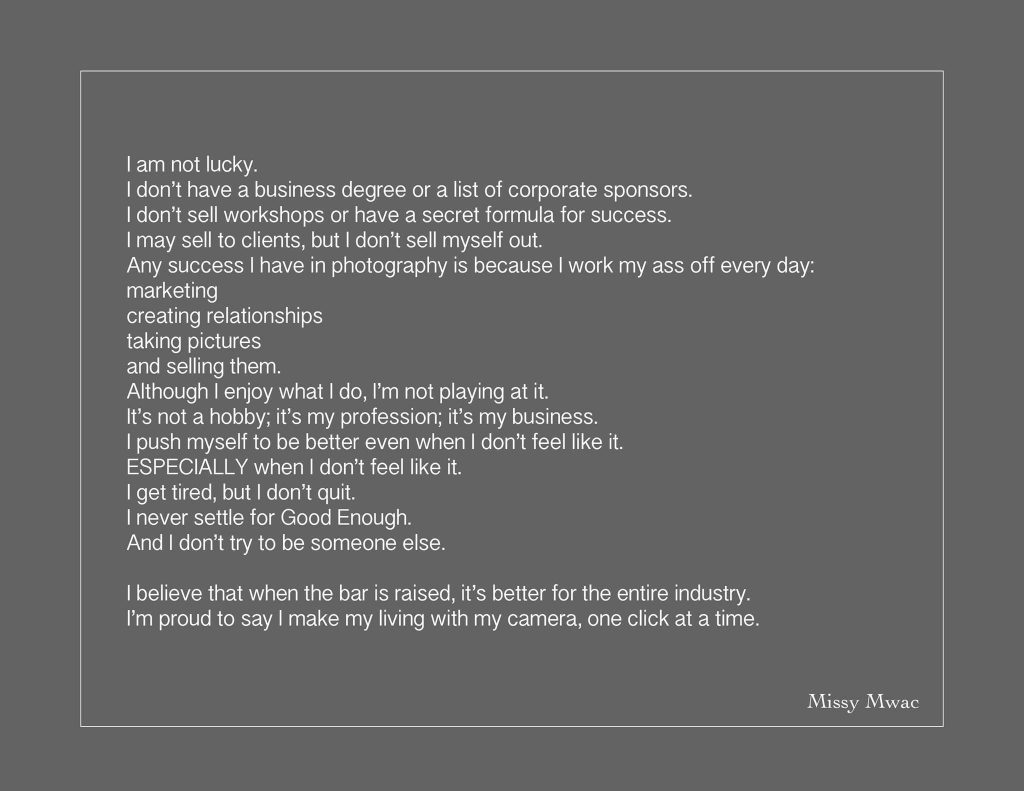Today is my Photographyversary. I started in this industry when I was 19, which means in dog years, I should be dead.
And in that time, I’ve seen a ton of changes. Some great, some awful. I’ve seen photographers and studios come and go. I’ve seen trends I’ve loved and some that I wish would die a fiery death. I’ve tried to avoid the sheep mentality, which means I’m more likely to turn left when the herd is turning right. A wise move? Well, I’m still here, so that’s something.
I look at the industry today and compare it to when I started and on the surface, it looks very very different. I am not one to reminisce about the “Good Old Days,” because they weren’t always good. (“I had to walk 5 miles to each wedding, barefoot, in the snow.”)
Now, I’m not one to shake my fist in the air and declare the days of film were far superior than the current state of digital, because they weren’t. Anyone who engaged in negative retouching will probably agree. The order consisting of 15-8×10’s of the same pose meant that you retouched the negative once, but the prints individually. That was way fun. Not. And don’t even get me started on pencils and dry dyes and suiting up like you were going into space just to use the spray booth to seal the pencil work and then when dried, pick up a print and scream:
“THERE’S A HAIR IN THE SPRAY!” after which you’d stomp around swearing before dissolving into a puddle of tears over the fact it had to be redone.
And then out came the lacquer thinner, that clunky metal can of chemicals. It stripped the spray off the print and the nail polish off your fingers and the color out of your clothing and the moisture out of your skin.
People, this was not fun.
But you know what WAS fun?
The fact that you had to know what you were doing, because you literally couldn’t afford NOT to. Film cost money and professional film cost the most. I’m not sure how other studios handled it, but in my studio, film was kept in a small fridge, and on my fridge was a sign that read: “Remember…$1.00 a photo.” It was a reminder to us all that when you added up the cost of the film and processing, it amounted to about $1.00 each time you pressed that button, so make each image count. You could not afford to “spray and pray,” i.e.: take hundreds of images and hope that some came out. You’d go broke in film and processing costs.
You also couldn’t “fix it in post.” Sure you could burn or dodge an image while printing, but if it was horribly under or overexposed, that baby was going to stay pretty much horribly under or over exposed.
You HAD to get it right in camera. There was no other option.
And I look back over my life in photography, and I don’t miss those days.
Changing film every 24 shots. Ugh.
Sitting at my art desk removing dust spots. Ugh.
A pile of images taped to cardboard awaiting retouching. Ugh.
Not being able to play as much as you wanted with your photography, because it cost money to do so. Ugh.
Yes, those days were a lot of work which I don’t miss, but having said that, I still declare that film was great. Why?
Because film was so freaking demanding.
It demanded you knew what you were doing.
It demanded a commitment…an investment.
Film made it difficult to pretend.
And although I’ve watched this industry I love change and twist and often become so far removed from what it’s really all about, I hold firm to the things I know to be true:
There is no substitute for experience; she is the greatest teacher, although many no longer see her value.
In-person sales are crucial to the success of a portrait photography business
Confidence must be wrapped in humility
You must learn how to sell if you want to succeed, and don’t tell me you can’t.
Stop texting your clients and start calling them
You must finish when you’re done, not when you’re tired
Your work must look like YOUR work and not someone else’s
You must value your clients and put their needs above yours
If you shift your focus away from your photography business, it will suffer
Because, my friends, after a lifetime in this industry that I LOVE, I have come to the conclusion that the truth is what the truth has always been: in order to succeed you must make a good product, charge appropriately, market it well, know how to sell it, and follow it up with great customer service.
That part will never change.
Now…I’m off to eat some cake. xoxo





Leave a Reply
You must be logged in to post a comment.